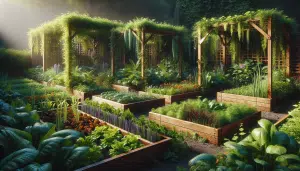Why You Should Try Raised Beds for Home Gardening
Lily Carter September 29, 2025
Discover why raised bed gardening is attracting so much attention among home gardeners seeking vibrant vegetables, easier maintenance, and beautiful outdoor spaces. This guide unpacks the benefits, how to start, soil tips, and ways to maximize your harvests using raised beds at home.
What Makes Raised Bed Gardening So Popular
Raised bed gardening is revolutionizing how people approach growing food at home, and for good reason. Unlike traditional ground plots, raised beds give you complete control over the soil, drainage, and even the ergonomics of gardening. Because the soil is elevated and contained, raised beds warm up faster in spring, which can mean an earlier start to the planting season and quicker growth for your vegetables and flowers. Growing in a raised bed also keeps your garden looking tidy and organized, adding instant curb appeal to your yard and making it easier to harvest without constantly bending over.
Another key reason for the surge in popularity is how raised beds can be a game-changer for anyone with back pain or mobility concerns. The height can be adjusted to suit your needs—some even choose tall or waist-high beds. This makes daily tasks like weeding, watering, and harvesting much simpler and less physically taxing. In urban settings where heavy clay or poor soil is common, raised beds allow for fresh, nutrient-rich topsoil to be installed, letting plants root deeply and thrive regardless of native conditions. The flexibility is unbeatable, encouraging gardeners to experiment with new plants and layouts.
Raised beds also tend to result in fewer problems with weeds and soil-borne diseases. Because you’re starting with a defined space and better soil quality, weed seeds are less likely to take hold. Mulching and row covers work particularly well in this controlled environment, offering added protection for your crops. This advantage leads to healthier plants and often higher yields, which many home gardeners find very satisfying. It’s easy to see why raised beds are often recommended for both beginners and seasoned enthusiasts seeking consistent, beautiful results.
Planning Your Raised Bed Garden
Good planning is essential if you want your raised bed garden to flourish. Start by choosing a location with at least six hours of sunlight per day, as most vegetables need full sun to produce well. Consider the proximity to water sources—lugging a hose across the yard is less appealing after a few weeks of hot weather! Raised beds should have easy access, so designing paths wide enough to move around without stepping on the soil helps keep compaction to a minimum. Many gardeners use mulch or gravel between beds for weed control and a neat appearance.
Size matters, too—four feet is the most popular width because this allows most people to reach the center of the bed without stepping inside. The length is flexible, but eight feet works well for most spaces and is easy to build using standard lumber sizes. Think about what crops you want to grow: leafy greens and herbs thrive in shallow beds, while root vegetables like carrots prefer at least 12 inches of soil depth. Mixing and matching bed depths in your garden can help you maximize your growing options and harvests.
Plan for irrigation in advance. Drip systems are a popular choice for raised bed gardens as they deliver water directly to plant roots and minimize waste. Simple soaker hoses or even hand-watering with a can are viable for compact gardens. Having a clear map of what crops will go where also enables more effective crop rotation and companion planting in future years, helping prevent pest buildup and depleting the same nutrients over time. Proper planning pays off with healthy plants and less work down the road.
Building Raised Beds: Materials and Designs
There are several material options when building raised garden beds at home. Cedar and redwood are classics due to their natural resistance to rot and insects. Pressure-treated wood is another option, though ensure it is certified safe for food-growing use. For longevity, many gardeners now opt for composite lumber, which won’t splinter or break down, or even recycled plastic kits that quickly snap together. Some creative gardeners upcycle materials like bricks, cinder blocks, or corrugated metal for a more industrial look. The design possibilities truly are endless, letting you personalize your space.
Building your own raised bed doesn’t have to be complicated. Start by identifying your layout and site. Beds can be installed directly on existing grass—just lay down cardboard or newspaper first to smother weeds, then fill with soil and compost. Most designs use simple boards for sides, attached with exterior screws or brackets at the corners. For taller beds, additional bracing in the center prevents bowing outwards when the soil is filled. If drainage is a concern, leave small gaps between boards or drill drainage holes especially for deeper beds and those made with non-porous materials.
Accessibility matters, especially in community gardens or homes with children or elderly individuals. Consider adding a ledge or bench along the top for comfortable sitting while you tend your crops, or use vertical trellises to allow climbing plants like cucumbers and beans to thrive without sprawling. Whether simple or elaborate, the raised bed structure should fit your yard and lifestyle. Taking the time to choose the right materials and design at the start ensures a productive, long-lasting garden and a welcoming outdoor space.
Choosing the Right Soil and Compost
Soil quality is one of the most important factors in raised bed success. Because you control the contents, it’s possible to create a fertile environment almost anywhere. Most raised beds perform best with a mix of topsoil, compost, and materials like coconut coir or peat moss for moisture retention. A typical blend for home use is one third each of topsoil, well-rotted compost, and aerating amendment. The result is a fluffy, nutrient-rich base that encourages deep rooting and improves water infiltration.
Many gardeners like to add organic matter from their own compost piles—it’s a cost-effective way to recycle kitchen and yard waste into valuable nutrients for the garden. Manure, if it is well aged and sourced from herbivores like cows or horses, can also be blended in to boost fertility. However, fresh manure should never be used, as it can burn plants and introduce pathogens. For new beds, consider adding trace minerals or slow-release natural fertilizers to give young plants a solid start during their early growing weeks.
Soil testing tools are widely available at local garden centers, letting you check for pH and nutrient levels before planting each year. This simple step ensures you know exactly what your plants need. Raised beds tend to drain more quickly than ground soil, so maintaining consistent organic matter is vital. Mulching after planting helps conserve moisture and suppresses weeds, reducing the need for constant watering. Over time, regular amendment with compost or leaf mold keeps beds fertile and productive for years.
Maximizing Harvests with Smart Planting
Raised beds offer a unique opportunity for efficient and intensive planting. With better soil aeration and fertility, crops can be spaced more closely together, which helps shade out weeds and retain soil moisture. Techniques like square-foot gardening—a system of dividing the bed into individual squares for each crop—work especially well here, maximizing both space and yield. Companion planting can also help deter pests: pairing carrots and onions, or basil with tomatoes, makes for a lush and healthy environment.
Successive planting is another strategy that extends the harvest all season long. Once an early crop like lettuce or radishes is finished, that space can be replanted with beans, summer squash, or fall greens. Interplanting fast-growing and slow-growing vegetables not only keeps the bed productive but also reduces bare patches that attract weeds and pests. Vertical supports such as trellises and cages make the most of limited spaces, enabling vining crops to grow upward instead of outward.
Keep track of what works—and what doesn’t—by keeping a simple garden diary or layout sketch every year. Rotating crops each season helps prevent soil exhaustion and the spread of certain diseases. Smart planting isn’t just about packing in as much as possible; it’s about understanding how crops interact and making adjustments as you go. Raised beds make it easy to tailor the growing environment, so you get more produce, less work, and continual learning each season.
Maintenance Tips for Long-Lasting Raised Beds
While raised beds generally require less maintenance than traditional gardens, a little annual care goes a long way. Inspect boards or materials each spring for rot, bowing, or loose screws, and replace or reinforce as needed. Renew the organic matter each season with a fresh layer of compost or well-rotted manure. Managing the soil’s health means fewer disease issues and healthier plants all summer. It’s a satisfying routine that keeps your garden at its best.
Pest control can be simpler in raised beds since barriers like row covers or hoop tunnels are easy to fit over the frame. Raised beds tend to drain more quickly, so keep an eye on moisture in hot weather—drip irrigation or mulch are valuable for avoiding drought stress. If weeds manage to find their way in, swift hand-pulling keeps them from spreading. By staying attentive and acting early, most maintenance tasks never become overwhelming.
Mulching not only saves water and reduces weeds, but also returns organic matter to the soil as it breaks down. Winter covers, such as straw or floating fabric, can help prevent nutrient loss and reduce erosion during storms. After the growing season, some gardeners cover beds with a green manure crop like clover, which can be tilled under in spring for a natural nutrient boost. Smart, steady maintenance leads to years of abundant and easy-to-manage home gardening.
References
1. University of Minnesota Extension. (n.d.). Raised bed gardening. Retrieved from https://extension.umn.edu/how/raised-bed-gardens
2. Cornell University Cooperative Extension. (n.d.). Building Raised Bed Vegetable Gardens. Retrieved from https://gardening.cals.cornell.edu/garden-guidance/vegetable-gardening/raised-bed-gardens/
3. The Old Farmer’s Almanac. (n.d.). Raised Garden Beds: How to Build & Where to Buy. Retrieved from https://www.almanac.com/raised-garden-beds-how-build
4. University of Georgia Extension. (n.d.). Raised Beds vs. In-ground Gardens. Retrieved from https://extension.uga.edu/publications/detail.html?number=1556
5. National Gardening Association. (n.d.). Raised Bed Basics. Retrieved from https://garden.org/learn/articles/view/4254/
6. Oregon State University Extension Service. (2020). Raised bed gardening. Retrieved from https://catalog.extension.oregonstate.edu/fs270







